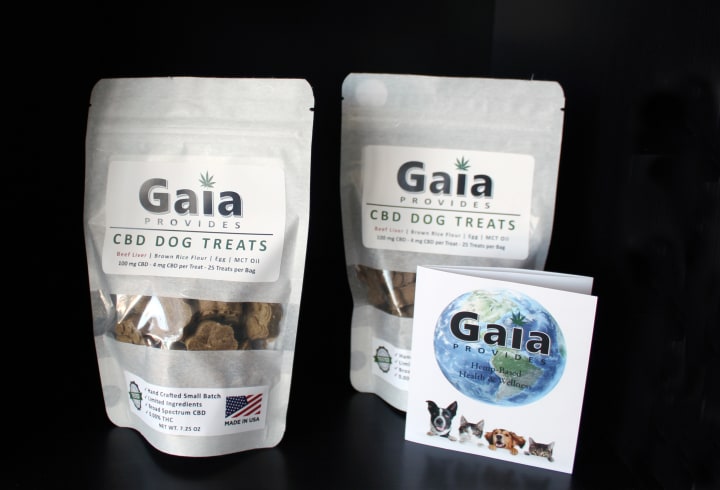Hemp Oil vs. CBD Oil: The Scientific Differences You Should Know
Do you have questions about why hemp oil and CBD oil are different from one another? If yes, then this educational blog is for you.

With the cannabis boom has come an explosion in consumer use and demand for CBD oil. The market is already a billion-dollar industry and growing bigger each day but education and legal policy lags like a cheetah with a broken leg.
Academic institutions are decades behind on research and understanding how cannabis works with your endocannabinoid system. The majority of the studies and knowledge about cannabis come from Israel - where Dr. Raphael Mechoulam, the pioneer of cannabis research, lives and studies the topic to this day.
What's most frustrating is the United States government holds a patent titled "Cannabinoids as antioxidants and neuroprotectants." Yet, they refuse to acknowledge the medicinal benefits of cannabis.
Here at GLAUX CHEM®, we won't stand idly by this nonsense and make every effort to educate our tribe about cannabis. In this exclusive blog, we explain what makes hemp oil and CBD oil different so you can make conscious buying decisions.
What is cannabis?
According to the Encyclopedia Britannica, cannabis is a class of flowering plants in the Cannabaceae family. There are three generally recognized plant types in this group and named Cannabis indica, Cannabis sativa, and Cannabis ruderalis.
You visually tell these different plants apart by the shapes and sizes of the leaves. All three of these cannabis plants produce a unique chemical class of fatty compounds called phytocannabinoids.
To understand how these three types of cannabis plants are connected, you can compare them to different kinds of peppers—like bell pepper, a jalapeno versus a habanero pepper. Meaning, all three peppers belong to the same plant family, but each looks, smells, and tastes different

How are hemp and marijuana distinguished?
Most people are not able to tell the difference between a hemp and marijuana plant by just looking at one. If you keep up with the news in the cannabis industry, surely you've read or heard stories about law enforcement wrongfully seizing pounds of "marijuana" when the confiscated stuff was hemp. This unfortunate mistake happens all the time.
The real distinction between hemp and marijuana comes from the amount of tetrahydrocannabinol (THC) produced in the flowers or buds. Generally speaking, hemp plants produce low levels of THC and will not get you high.
In contrast, marijuana plants are ripe with THC once you smoke or consume marijuana, well, hello, kite city.
Here is a list of things you can use to contrast the two plants:
Hemp
- Cannot get you high
- Flowers contain less than 0.3% THC by dry weight
- Are cultivated outdoors for industrial applications
- Seeds, stalks, and leaves used to produce medicine like CBD oil and consumer goods like clothing, paper, fuel, and ropes
Marijuana
- Will get you high
- Flowers can contain up to 30% THC by dry weight
- Farmed indoor or outdoor for medicinal applications
- Used to make cannabis oil, extracts, edibles, and topicals
Historical facts about hemp
The first recorded use of hemp dates back to China around 1500 BCE before the time the Egyptians built the great pyramids. Talk about an old plant, whew! These ancient folks cultivated hemp for the production of clothing, paper, food, or as a medicine to treat pain, which is similar to the many applications we rely on the plant for today.
In the United States, historical records suggest the first hemp plants introduced in the Colonies by the 16th century. Hemp was an integral part of our nation during the 1700s that farmers were required to grow the plant. This crop was utilized to fabricate rope and rigging for ships, paper, and fuel, to name a few things.
A fact people do not know is Thomas Jefferson drafted the Declaration of Independence on hemp paper. Also, our first president George Washington grew hemp, and the great Honest Abe Lincoln, who famously freed the slaves, used hemp fuel to power his lamps.
How awesome, right? With such a rich history rooted in our past, it is hard to believe hemp was outlawed.

Industrial uses of hemp
Hemp is inarguably one of the most versatile and sustainable plants on the planet—anything from cotton, plastic, or petroleum you can make from hemp.
From the plant leaves, stalks, and flowers; every piece of the plant is harvested and processed to produce consumer goods or medicine. Clothes, paper, and plastics, for example, are processed from the high fibrous plant stems that are ripe with a substance called lignan.
Lignan is a tough woody like substance used to make a natural concrete conveniently named "hempcrete." Some perks of using this material as a building block for homes include soaking up carbon dioxide from the air, plus fire and pest resistance.
At a time when our planet is suffocating from plastic pollution, warming, and burning at unprecedented rates, the resurgence in hemp goods is everything our world needs to survive and thrive.
How do you make hemp oil?
Hemp oil is lightweight and nutritionally rich, made via a chemical technique called extraction. There are few ways to produce hemp oil, and the method of extraction widely affects the chemical makeup of the oil.
Cold-pressed extraction of hemp seeds is a technique that uses pressure and low temperature to expel the plant goodies. This method of unrefined extraction is beneficial and provides the most nutrient-rich oil, preserving the omega fats, plant pigments, and other temperature-sensitive molecules.
Another way to produce hemp oil is through a solvent-based extraction of the plant stalks, leaves, and stems. Solvent extractions involve some form of chemical refinement, like heat or purification, to separate the solvent from the oil. The final hemp oil product made in this manner lacks the body-loving unsaturated fats and colorful pigments like chlorophyll.

Benefits of hemp oil
There are copious bodily benefits that come with using hemp oil. If you did not already know, hemp is a superfood, packed with a plethora of nourishing compounds like protein, fats, vitamins, and minerals.
Hemp seeds contain all of the essential omega fatty and amino acids your body needs, but cannot physically make, to function. Omega-3 fats provide support to your brain, eyes, heart, skin, and immune system, for instance. Amino acids are the smaller pieces your body uses to make protein.
Some well-known benefits that come with eating hemp foods are:
- Heart health—fends off cardiovascular disease and improves your blood circulation by lowering your triglyceride levels
- Skin health—protects your skin from dryness, aging, and fights the good fight against chronic inflammatory conditions like eczema and psoriasis
- Brain health—keeps your brain sharp by protecting your cells from damage by free radicals
These are just a few of the many good things that come with consuming hemp. If you are looking to improve your overall health, upping the amount of hemp in your diet is a great way to start the journey.
What is CBD?
CBD is an abbreviation for the chemical compound cannabidiol and made in hemp and marijuana. This molecule is made exclusively by plants. Contrary to the name CBD oil, pure CBD does not exist naturally as an oil or liquid.
If you remember back to chemistry class in high school, you were taught that matter exists in three phases—solid, liquid, and gas. Well, pure CBD is, in fact, a white crystalline solid, just like the sugar you buy from the store.
Of course, you cannot buy pure CBD from the store like sugar, but we use the comparison to help you understand how CBD and CBD oil are different.

How do you make CBD oil?
Now that you know pure CBD is a solid and not oil at room temperature, you might wonder how to make CBD oil. There are few types of CBD oils out there, like full-spectrum, broad-spectrum, or isolate, but in this article, we only consider CBD oil made from an isolate.
The process of making CBD oil is a bit complex and relies on a combined mixture of extraction and purification steps to get pure solid stuff or isolate. After you obtain the pure CBD, then comes the step of preparing CBD oil by mixing solid CBD with an oil.
Some conventional oils people use are fractionated coconut oil, hemp oil, or olive oil. The type of oil you use to make CBD oil does not matter as long as the starting CBD is pure and dissolves into the oil.
Benefits of CBD Oil
Nowadays, hundreds of thousands of people use CBD oil to help relieve pain, stress, anxiety, improve sleep, and improve their overall quality of life.
Not only that, but plenty of people give their pets CBD oil for many of the same reasons they use the oil—to reduce pain, joint stiffness, and anxiety. Animals have endocannabinoid systems, too, so there is an excellent reason to give your pets CBD oil as well.
The truth is there is an abundance of medical issues that CBD oil and other CBD products can help with and backed by science:
- Alzheimer's
- Parkinson's
- Neuropathy
- Insomnia
- Epilepsy
- Arthritis
- Anxiety
- Stress
This list of ailments is by no means exhaustive, but rather some of the frequent reasons people choose to consume CBD oil.

What are cannabinoids?
Cannabinoids are a group of fatty molecules that activate your endocannabinoid system. They come in two different types, endocannabinoids (endo = endogenous) and phytocannabinoids (phyto = plant). Endocannabinoids are made in both humans and animals, while plants like cannabis and marijuana produce phytocannabinoids.
The two most common endocannabinoids naturally found in animals are AEA and 2-AG, both discovered by the Israeli chemist Dr. Raphael Mechoulam. Endocannabinoids and the receptors that bind to and interact with these compounds are spread all over your body.
You can find phytocannabinoids in both hemp and marijuana plants, like CBD and THC. To date, there are over 100 known unique plant cannabinoids, and this number is growing every year.
Some of the well-recognized ones and benefits they provide your body are:
Cannabidiol (CBD)
- Anti-anxiety
- Anti-seizure
- Anti-inflammatory
- Anti-depressant
- Reduces artery blockage
Tetrahydrocannabinol (THC)
- Anti-nausea
- Relieves pain
- Anti-depressant
- Anti-inflammatory
- Suppresses muscle spasms
Cannabigerol (CBG)
- Anti-biotic
- Anti-fungal
- Anti-anxiety
- Anti-inflammatory
- Promotes bone growth
What is your endocannabinoid system?
You can think of your endocannabinoid system as the ultimate internal regulator that keeps all your body's in balance. Studies show this system works with your brain, heart, immune, skin, bones, hormones, etc.
Unlike the nervous system discovered in the 4th century, the endocannabinoid system was only discovered the 1990s, so we have centuries of learning and catching up to do.
Here is a brief list of some things we do know about how the endocannabinoid system works in conjunction with your body:
- Immune—calms inflammation and help prevent chronic inflammation by keeping your immune cells in check
- Heart —controls blood pressure, flow, and fights against plaque build-up in your arteries that cause heart disease
- Brain —regulates pain, mood, sleep, appetite, and hormone release
- Bones —stimulates new bone growth and helps repair broken bones
- Skin —balances oil production, fights acne, aids wound healing and reduces the formation of scar tissue
How to activate your endocannabinoid system
There is a theory coined by Dr. Ethan Russo called the "Clinical Endocannabinoid Deficiency," which presumes that a large number of medical problems like seizures, pain, arthritis, anxiety, and depression arise from a lack of endocannabinoids in the body.
Here are some ways to activate your endocannabinoid system:
- Consuming cannabis products like flowers, tinctures, edibles, and topicals
- Eating bell peppers, jalapenos, serranos, or habaneros
- 30-minutes of cardio exercise at least 3 times a week
- Eating hemp foods, flax seeds, and avocados
Supplementing your body with these cannabinoids with either plant or human-made ones to fill the void may alleviate the severity of these medical conditions.
We have a lot more to learn about how endocannabinoids and the associated receptors work within your body, but based on what we know about the medicinal properties of cannabis, this theory may hold.
Summing up
Hemp oil and CBD oil are not the same thing chemically. Think of CBD as the child of the cannabis plant. You can make CBD oil from hemp oil, but you cannot make hemp oil from CBD oil.
CBD oil and other CBD products are traditionally used for medicinal purposes and hemp oil for nutritional or cosmetic reasons.
Both oils contain plant versions of cannabinoids, like CBD, that activate your endocannabinoid system, which helps your body stay in harmony.

About the Creator
GLAUX CHEM®
Our mission is to help those with skincare needs by developing natural products that are inspired by Mother Nature. Learn more at https://www.glauxchem.com.






Comments
There are no comments for this story
Be the first to respond and start the conversation.